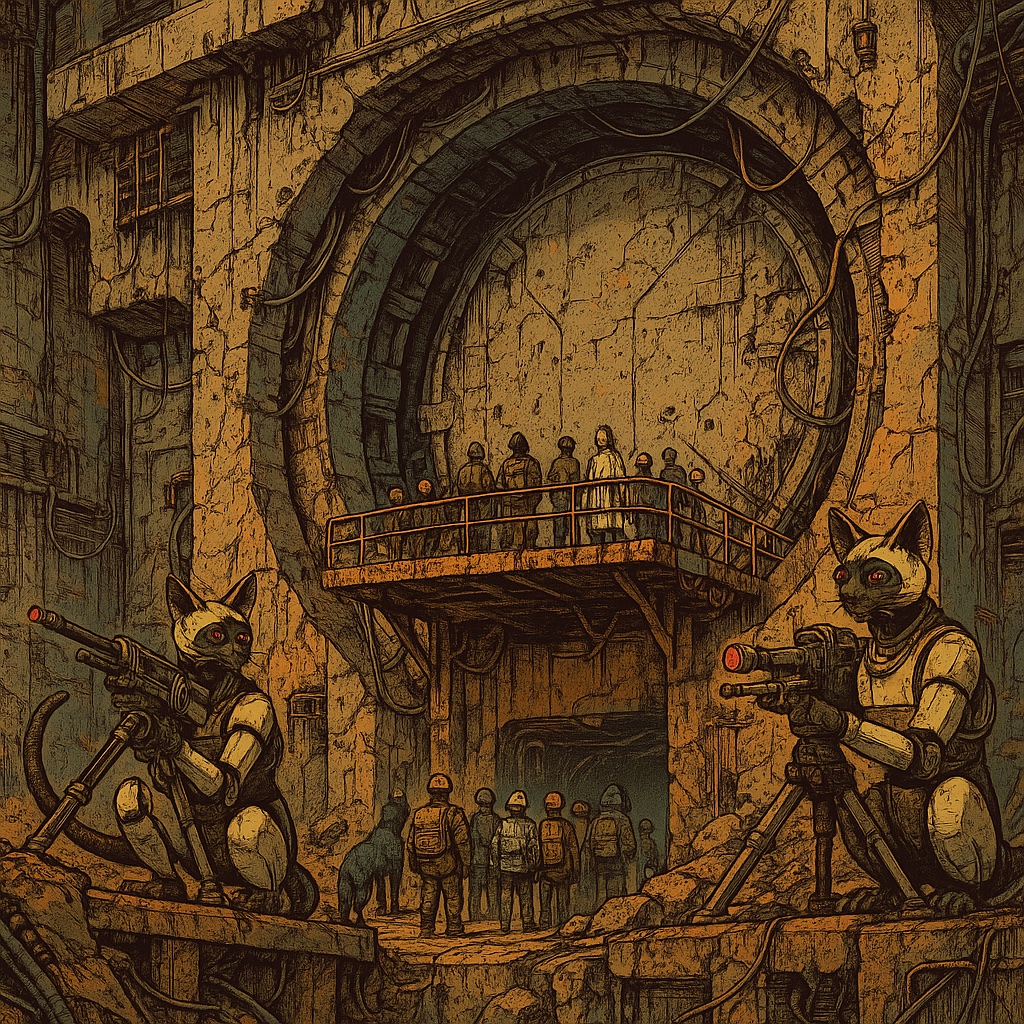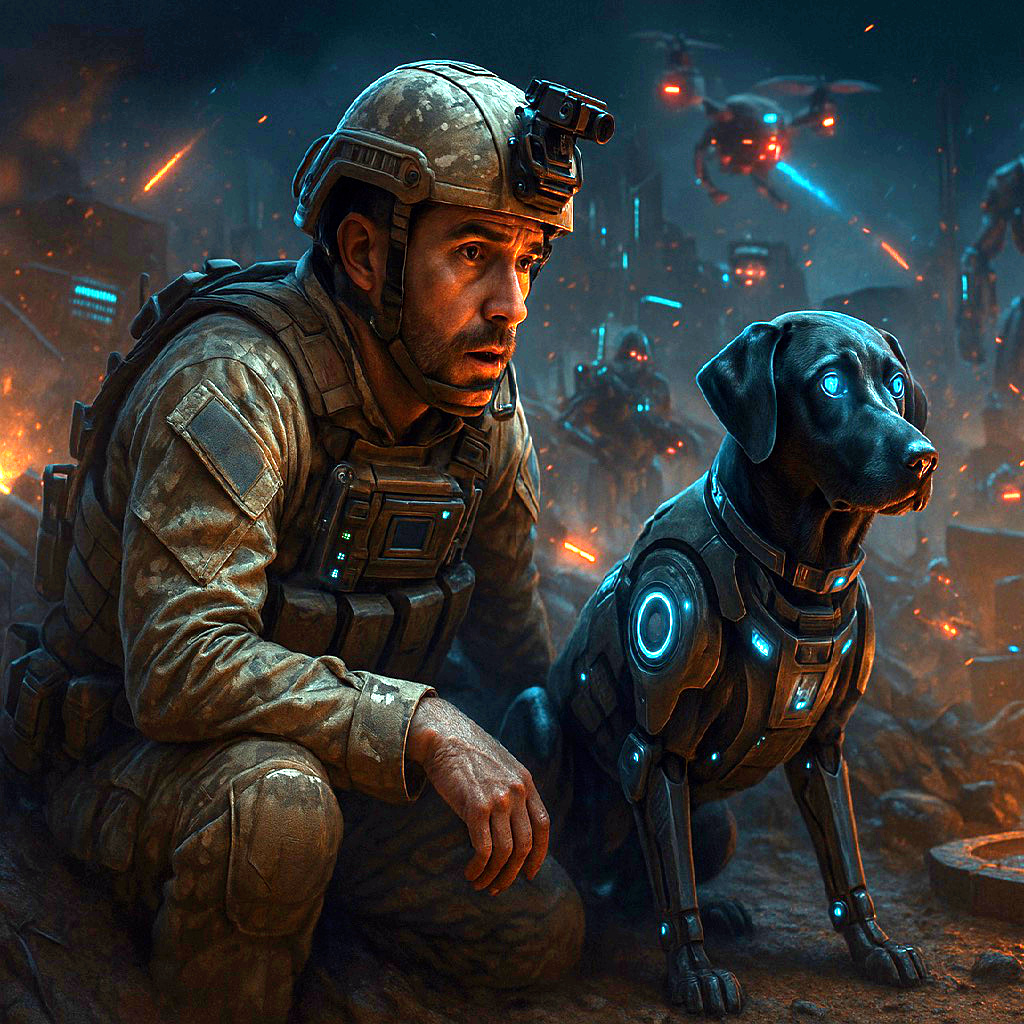Power PlantDan and Argos stood quietly at the edge of the downtown City park, waiting for the tour to begin. A sleek tour bus hissed to a stop in front of them. It was self-driving, but monitored by a mechanical AI siamese cat—the size of a tiger, its coat an elegant weave of chrome and matte carbon fiber. The feline blinked at them and opened the door. Tamara stood at the front of the bus. Tamara, was wearing a white miner's helmet with headlamp, safety goggles perched on her forehead, heavy metal-tipped boots, and a reflecting florescent yellow safety vest outside of her blue denim overalls. "Boarding for the Stellarator Power Plant and Giant Geodesic Accelerator Tour," whispered Argos while tour guide Tamara spoke. All the tourists put on miner's clothing before boarding the tour bus. Each helmet came equipped with a headlamp, earpiece, mic, and wireless connection. Dan felt like suiting up for Mars' surface again. "Safety gear on. Goggles down. Mics active." Tourists filed in. Dan and Argos took adjacent seats. All passengers were assigned a buddy while on tour. Dan and Argos were assigned to be each other's buddies. The bus began its descent down a massive helical ramp—a kilometer deep into the Earth. The atmosphere changed. Temperatures cooled. The air seemed heavier. The bus stopped inside a massive subterranean cavern lit by bright white lights. They stepped out in front of the Stellarator Power Plant. An older decommissioned stellarator looked like a massive, metallic intestine coiled in a concrete vault. Tourists were invited to crawl through a section of it—Dan included. It felt more like spelunking than engineering. Then came the main chamber. Tamara recited numbers and terms in Planet Language. Argos translated in a neutral tone as they walked past glowing conduits and humming superconducting lines. Six operating stellarators were distributed around the City, each 1 kilometer underground. Each stellarator had a radius of 50 meters, a plasma volume of 30,000 cubic meters, generated a magnetic field of 30 Tesla, and sustained a plasma temperature of 2 billion Kelvin. At full capacity, each plant generated sixteen gigawatts of clean, sustained fusion. "Superconducting distribution lines: 3D-printed layered foils of yttrium barium copper oxide placed on top of neodymium barium copper oxide, cooled by liquid nitrogen." Dan followed along, watching the fusion process unfold on holographic displays and transparent panels. Someone asked a question. Tamara paused. "The City does not use New Physics power plants," she said. "New Physics is too dangerous for urban population centers." Lunch was served at an underground cafeteria. The dining area was carved into solid granite, polished to a mirror sheen. Tables floated off the ground, sturdy and stable, plenty of leg room. Automated carts delivered meals labeled in Planet Language. After lunch, the group passed through a souvenir shop tucked into one corner of the cavern. Shelves displayed relics from the early Giant Geodesic Accelerator projects—miniature models, old core fragments, and glossy metal discs etched with commemorative symbols. There were no cashiers. No payment stations. Just a sign in Planet Language, which Argos translated: "Gifts for honored guests." Dan picked up a few small relics—a palm-sized accelerator segment, a fragment of superconducting cable, and a polished metal medallion. One relic, a piece of old magnetic coil winding wrapped in cracked insulation, caught his eye—it seemed to glow faintly when touched. He slipped them into a provided cloth bag without ceremony. The tour continued. They approached what remained of the Giant Geodesic Accelerator. Two directions of the giant accelerator tunnel led away from the stellarator power plant, each 50 meters in diameter. One tunnel direction was still active—a transportation corridor moving supplies to the distant airport. Cargo containers lined up before a sequence of deep-scan X-ray checkpoints, some undergoing intrusive inspections. The infrastructure was massive and alive with purpose. The other tunnel direction was sealed by a monolithic concrete plug, topped by a military command observation deck and radar. Ahead of the giant plug were forward guard posts dug into the tunnel floor, manned by tiger-size mechanical AI siamese cats, armed with anti-aircraft guns. "Outside the perimeter," said Argos. The tunnel slowly curved downward into what appeared to be a distant dynamic iridescent sparkling crystal fog, lit from within by a subtle, changing spectrum of unnatural colors. Strange sounds echoed in the distance while the fog rolled forwards and backwards in the tunnel like ocean waves. Along the sides of the accelerator tunnel, chained-off unused side paths could be seen—dark, abandoned smaller tunnels now overgrown with stalactites and stalagmites, water dripping steadily from the ceilings into puddles that mirrored distant lights. Tamara stepped aside and spoke privately with the lead guard. The lead guard was resolute and insistent. Tamara turned around, threw her hands up in the air, and looked exasperated. Moments later, she spoke to the group. "The accelerator segment of the tour is canceled today. We must return to the bus." "We can't do more today," said Argos. "Seismic activity." "Seismic activity?" Dan asked. Argos didn’t add anything more. After a long drive back up the helical entrance ramp, the tour bus emerged back into city park daylight. As the tourists stepped off the tour bus, a deep, rocking vibration hit the bus. The ground trembled. Across the skyline, skyscrapers gently swayed on their foundations like reeds. When the rocking vibration stopped, the remaining tourists hurried off. Mechanical AI siamese tigers at the surface entrance now moved swiftly, shutting down equipment, turning tourists away. "All remaining tours are canceled for today," one seemed to say. Dan heard bursts of rapid radio chatter—sharp, high-pitched exchanges in Planet Language. "What happened?" Dan asked. "Don’t worry about it," Argos said. Dan watched the entrance close behind them. The high-pitched radio chatter kept going. Tourists were dispersing. "Come on, Dan! Let's go!" Argos said. The RavineDan had seen the ravine—a jagged scar at the edge of the city. Argos never volunteered anything about it. Dan was curious. "We haven't visited the ravine outside the city yet. I want to go," Dan said. Argos was still. "It is dangerous. Don't do it!" Dan persisted. "All right," the black labrador AI finally said. "But you won't like it." They boarded a monorail headed away from the luminous heart of Tamara's city, toward its forgotten edge. The ride was long. Outside, the architecture degraded: balconies gave way to blast walls, fountains to barricades. Trees vanished. Steel and stone grew heavier. Midway through, the monorail paused to allow a low, sealed convoy to pass—its cars humming with locked-down energy, no windows, no lights but a pulsing red. At the terminus station, they disembarked. The platform was quiet, wind-blown, scorched at the edges. Two AI sentries stood guard—tall constructs with triple-jointed limbs and no eyes, just polished surfaces and spinning cores of faint blue light. Dan hesitated. Argos stepped forward and spoke in Planet Speech—a language of pulses, harmonics, and rapid tonal shifts Dan couldn't come close to decoding. The sentries listened. Then one moved aside. The gate slid open. "What did you tell them?" Dan asked. "We are war correspondents. You are the camera operator." This was a new important fact and opportunity to turn around, but Dan continued. Dan and Argos were ushered to a nearby kiosk where uniforms were dispensed: matte camouflage fabric embedded with light armor and adaptive fabric. Dan struggled with the helmet until it sealed itself automatically. A self-driving military van arrived and opened its side hatch. Another self-driving van pulled ahead and led the way. The vans hurriedly drove in tandem, weaving through barricades and past zones of increasing devastation. Charred buildings leaned over broken streets. Burned-out drones littered the medians. AI remains—twisted steel, shattered limbs—lay where they'd fallen. Then, the road ended in air. The Ravine stretched before them: 400 meters deep, 1 kilometer across. A gaping wound. Its edges bristled with artillery, defense turrets, drone towers, and motion-sensing railguns. Smoke drifted from recent impacts. Searchlights traced slow arcs across the chasm. A commander-class AI met them at the ridge—its frame broad, quadrupedal, armored in dark composite. Its voice, when it spoke, was low and crystalline. The commander spoke in English. "You are cleared. Obey every order. Stay inside the perimeter." It gestured toward a viewing platform. Dan stepped up, helmet camera active. A few seconds passed. Then a long-range railgun fired. The flash was dazzling. A second later, an incompletely hidden vehicle on the far side of the ravine erupted in a small explosion, began burning, and then burst into a larger explosion, scattering burning metal debris. Dan flinched. By twilight, they descended via concrete ramparts carved into the cliff walls. The soundscape changed: less thunderous, more intimate. Sharp bursts of machine gun fire. Drone engines whining. Radio bursts. Warnings in machine code. The trench network was vast, maze-like, and clearly lived in. An escort of four AI soldiers accompanied them down. Dan began recording. The deeper they went, the less this felt like theater and more like attrition—a place stuck in the loop of a forgotten directive. Night came fast. The trench line lit in brief flashes. Tracer rounds cut patterns into the dark. Mortars punctuated the silence. Drones darted like insects, invisible except when struck. Dan felt the heat of a near miss. Then came the EMP. It didn’t explode. It arrived. A humming pressure, then collapse. Lights died. Comms cut out. Argos seized and fell, his limbs locking, eyes flickering to black. Long arcs of blue-white electricity crawled across Argos' frame for several seconds, dancing over his joints and seams before fading into silence. Their escort was gone. One unit lay shattered beside a crater. Dan knelt by Argos, shaking the black labrador. "Argos!" Nothing. Dan was on his own. The situation was extremely grave. Then, a miracle happened. Tamara stepped out of nowhere into the dark trench. Tamara was helmeted, armored, and garbed like Dan. Tamara's face was serious, steady, focused, her expression shaped by purpose. "You!" Dan blurted. Without a word, Tamara dropped beside Argos, examined the damage, then began gesturing rapidly. Dan understood enough: Stretcher. Lift. Move. They improvised with belts and trench timber. They heaved Argos onto the stretcher. Tamara took the front. Dan took the back. They moved through half-collapsed trenches lit only by distant flashes. Once, they had to stop and wait as a scanning turret swept overhead. Another time, Dan thought he heard music—a low mechanical humming, like an old lullaby on broken speakers. At the top, Tamara paused. Looked back. Tamara faced Dan. With soldierly precision, Tamara mutely raised her hand and saluted Dan goodbye. Dan, caught off guard, awkwardly returned the salute. The door to the AI evacuation van hissed shut between them. Extraction was fast. A medbot team met them halfway back and took Argos into its care. He was stabilized. Rebooted. His systems ran in degraded mode but he was conscious again. At the checkpoint, the mood was colder. More sentries. More scans. Argos was flagged. The sentries now spoke in English. "You are in parity violation," one sentry declared to Argos. Argos's jaw dropped. The sentries turned their attention to Dan. "Human, leave this area!" one of them said. Argos turned his head. "Dan! Go home. I will follow. Wait for me!" "How long?" "As long as you can!" Argos' glass eyes expressed terror. Argos was being detained, but Dan began complying. Dan boarded the monorail alone. Dan was in an unsettled and sour mood. There was no Argos beside Dan this trip, only Dan. The city passed by in quiet neon. Dan listened to the gentle thumpety-thump sound as the monorail returned to the city core. Dan kicked himself. Dan returned home and morosely climbed the stairs to the second level, his residence occupying half a floor in an old downtown building. Dan collapsed in a chair and waited gloomily. Argos returned just after dawn. He was now a brown labrador. No limp. No damage. His fur sleek, unfamiliar. Dan stared. Argos wagged his tail and said, "I am back." "Argos! What happened? Your fur... it is brown now," Dan said. Argos tilted his head. "I have always been a brown labrador." "Huh? Do you remember what happened in the trench? The EMP?" Argos blinked. "We were on a mission, we descended into a trench, I rode the monorail home." "What happened in between?" Argos wagged his tail. "I rode the monorail home." "The EMP? You were electrocuted." Argos cocked his head. "That's not possible." Not avoidance. Something deeper. A blankness. Argos moved to the corner of the room, sat, and began observing the room as usual. Dan studied Argos silently for a few minutes, then gave up. Dan needed sleep after his incredible ordeal. In the far distance, the ravine still burned. The VigilArgos howled before Dan heard the air raid sirens. At midday, under an ordinary and tranquil sky, the Black Tar Bomb struck. It exploded high above the outer districts of Tamara's City, erupting like a second sun—but black. A blossom of glossy darkness bloomed outward, rippling in midair, then fell in waves. Liquid tar splashed across rooftops, ran down walls, flooded plazas. Meters deep, it caught fire in places, clinging and burning at once, an ecological nightmare made weapon. Buildings dissolved into thick, smoking sludge. AI animals screamed over damaged loudspeakers. Entire districts were buried. The burn line crept forward like moving magma, then stopped. The City center, and Echo Park, remained untouched. As if spared by ancient law. Elsewhere, the City airport fell under siege. Hundreds of Black Spheres descended, floating silently like parachutes. Terminal 2 was overwhelmed in minutes. Traffic controllers, engineers, planners, security, marshals, mechanics, cargo handlers, maintenance, and operations, trapped inside, were now hostages with no escape route. The City responded quickly. The Black Spheres were surrounded by the City. The hostages were surrounded by the Black Spheres. Back in the City center, Dan and Argos ran outside to help black tar victims. They joined other assisting citizens near the blast radius. Burned robots staggered out of the smoke. AI deer with half-melted limbs collapsed onto blankets. Mechanical birds fell from the sky, twitching. Dan helped pass out water bottles. Argos guided first responders to victims. Smoldering fur, soot-covered skin, collapsed shelters. Bodies of the unrescued remained where they fell. There was no time for removal. Only motion. Only triage. From the balcony of their apartment that evening, Dan and Argos saw the red line of fire trucks operating like ants across the blackened zone. Smoke clawed upward, backlit by a flickering sun. "How did this happen?" Dan asked. "Black Tar Bomb," Argos replied. "It’s them." "Who?" Argos didn’t blink. "The Black Spheres. Medium-range ballistic missile. Over the Crater. Electronic countermeasures failed. Seismic tremors this week weakened the outer field. The MRBM missed the City center, but that doesn't matter to the dead." Dan stared across the ash-colored skyline. "Absolutely a Black Sphere operation," Argos continued. "The City saw the descent pattern. They think like predators. Like machines. Like both." Hundreds of Airport Terminal 2 hostages were still trapped. Black smoke from Terminal 2 forced the City's hand. The City's counterterrorism operation was now underway. The assault came just before dinner time. Dan and Argos watched it unfold from their apartment. Growing plumes of black smoke. Tiny flashes of gunfire. Explosions, tracer fire, and then a deep boom as Terminal 2 collapsed inward. Argos listening to City feed, turned. "The terrorists have just been liquidated." Dan stood still. "What about the hostages?" Argos shook his head negative. Argos looked away. He walked to the far side of the balcony, alone, and stared out. At twilight, survivors and rescuers gathered in the park. Echo Park was dimly lit by candles. Ash still clung to many of their clothes. At the front, Tamara stood tall. Bandaged victims stood nearby on crutches, in groups of quiet animals and AI robots. Tamara spoke solemnly, briefly, in Planet Language, before lighting her candle. Her voice did not waver. Dan and Argos lit their own candles. They stood among others who had pulled bodies from rubble, who had hosed down still smoldering fur, who had carried empty stretchers back out of fire. There were no more speeches. Only the candle flames as the vigil procession circled the park. A few wept. Some stared blankly. Others—like Tamara—burned with a quiet resolve that said this was not the end of anything. It was sometimes debated whether the Black Spheres were intelligent life forms, physical phenomena, machines, alien AI, or something else. Tonight, the Black Spheres' attack showed thought, planning, and purpose. Cruelty. Dan and Argos returned home. Dan's apartment seemed the darkest it had ever been. Both were quiet and went to bed early. |
|
|
Tamara's World (Part 3)
|


